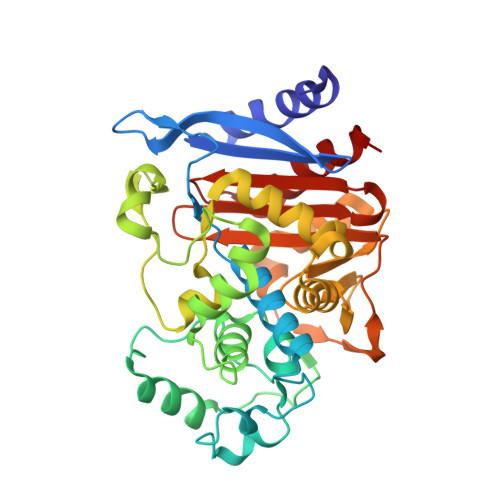The complexed structure and antimicrobial activity of a non-beta-lactam inhibitor of AmpC beta-lactamase.
Powers, R.A., Blazquez, J., Weston, G.S., Morosini, M.I., Baquero, F., Shoichet, B.K.(1999) Protein Sci 8: 2330-2337
- PubMed: 10595535
- DOI: https://doi.org/10.1110/ps.8.11.2330
- Primary Citation of Related Structures:
1C3B - PubMed Abstract:
Beta-lactamases are the major resistance mechanism to beta-lactam antibiotics and pose a growing threat to public health. Recently, bacteria have become resistant to beta-lactamase inhibitors, making this problem pressing. In an effort to overcome this resistance, non-beta-lactam inhibitors of beta-lactamases were investigated for complementarity to the structure of AmpC beta-lactamase from Escherichia coli. This led to the discovery of an inhibitor, benzo(b)thiophene-2-boronic acid (BZBTH2B), which inhibited AmpC with a Ki of 27 nM. This inhibitor is chemically dissimilar to beta-lactams, raising the question of what specific interactions are responsible for its activity. To answer this question, the X-ray crystallographic structure of BZBTH2B in complex with AmpC was determined to 2.25 A resolution. The structure reveals several unexpected interactions. The inhibitor appears to complement the conserved, R1-amide binding region of AmpC, despite lacking an amide group. Interactions between one of the boronic acid oxygen atoms, Tyr150, and an ordered water molecule suggest a mechanism for acid/base catalysis and a direction for hydrolytic attack in the enzyme catalyzed reaction. To investigate how a non-beta-lactam inhibitor would perform against resistant bacteria, BZBTH2B was tested in antimicrobial assays. BZBTH2B significantly potentiated the activity of a third-generation cephalosporin against AmpC-producing resistant bacteria. This inhibitor was unaffected by two common resistance mechanisms that often arise against beta-lactams in conjunction with beta-lactamases. Porin channel mutations did not decrease the efficacy of BZBTH2B against cells expressing AmpC. Also, this inhibitor did not induce expression of AmpC, a problem with many beta-lactams. The structure of the BZBTH2B/AmpC complex provides a starting point for the structure-based elaboration of this class of non-beta-lactam inhibitors.
Organizational Affiliation:
Department of Molecular Pharmacology and Biological Chemistry, Northwestern University Medical School, Chicago, Illinois 60611-3008, USA.















